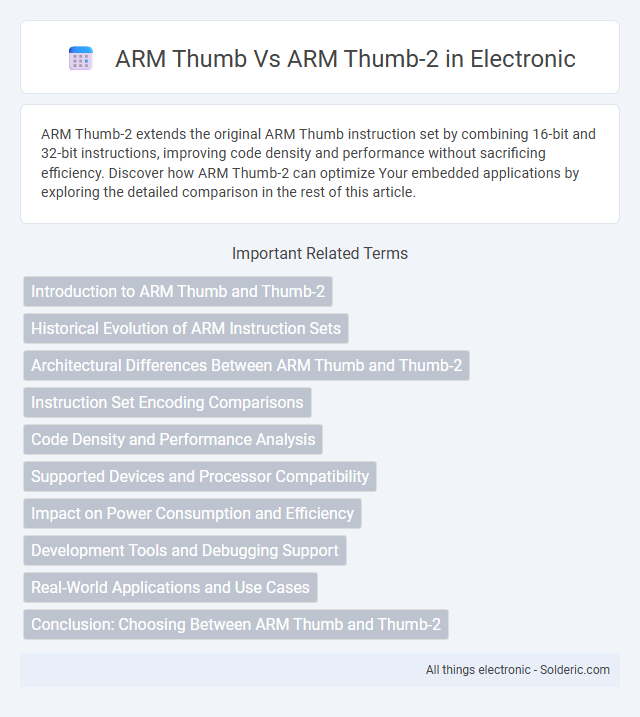ARM Thumb-2 extends the original ARM Thumb instruction set by combining 16-bit and 32-bit instructions, improving code density and performance without sacrificing efficiency. Discover how ARM Thumb-2 can optimize Your embedded applications by exploring the detailed comparison in the rest of this article.
Comparison Table
| Feature | ARM Thumb | ARM Thumb-2 |
|---|---|---|
| Instruction Length | 16-bit fixed | Mixed 16-bit and 32-bit |
| Code Density | Improved over ARM | Higher, combines density and performance |
| Instruction Set | Subset of ARM | Extended with additional ARM instructions |
| Performance | Moderate, limited by 16-bit ops | Better, supports complex operations |
| Register Usage | Limited registers accessible | Full ARM register set accessible |
| Branch Range | Shorter branching distances | Extended branch range |
| Application | Legacy embedded systems | Modern embedded and real-time systems |
Introduction to ARM Thumb and Thumb-2
ARM Thumb is a 16-bit instruction set designed to improve code density and reduce memory usage in embedded systems, enabling efficient use of limited resources. ARM Thumb-2 extends this architecture by combining 16-bit and 32-bit instructions, enhancing performance and flexibility without significantly increasing code size. Your development process benefits from Thumb-2's improved computational capabilities while maintaining compatibility with existing Thumb code.
Historical Evolution of ARM Instruction Sets
ARM Thumb introduced a 16-bit compressed instruction set to enhance code density and improve performance on embedded systems with limited memory. ARM Thumb-2 evolved this concept by blending 16-bit and 32-bit instructions, offering greater flexibility and efficiency while maintaining compatibility with existing Thumb code. Your embedded applications benefit from increased performance and reduced code size through ARM Thumb-2's advanced instruction set enhancements.
Architectural Differences Between ARM Thumb and Thumb-2
ARM Thumb uses a uniform 16-bit instruction set optimized for code density, while ARM Thumb-2 extends this with mixed 16-bit and 32-bit instructions to enhance performance and flexibility. Thumb-2 supports more complex operations and richer instruction encodings, enabling improved execution efficiency without significantly increasing code size. Your applications benefit from Thumb-2's architectural enhancements, offering better control and higher throughput compared to the original Thumb instruction set.
Instruction Set Encoding Comparisons
ARM Thumb uses a 16-bit compressed instruction set aimed at reducing code size, whereas ARM Thumb-2 extends this with a blend of 16-bit and 32-bit instructions to improve performance and code density. Thumb-2 maintains backward compatibility with Thumb while introducing richer instruction encoding that supports more complex operations and enhanced control flow. The combination of variable-length instructions in Thumb-2 enables more efficient use of memory and processor resources compared to the fixed 16-bit instructions in classic Thumb.
Code Density and Performance Analysis
ARM Thumb-2 significantly improves code density by integrating 16-bit and 32-bit instructions within the same instruction set, enabling more compact and efficient code compared to the original ARM Thumb, which uses only 16-bit instructions. This enhanced encoding flexibility allows Thumb-2 to deliver better performance through reduced memory footprint and fewer instruction fetches, optimizing pipeline efficiency and reducing energy consumption. Benchmarks demonstrate that Thumb-2 can achieve performance levels close to full 32-bit ARM instructions while maintaining superior code density, making it ideal for embedded systems with limited resources.
Supported Devices and Processor Compatibility
ARM Thumb architecture supports a wide range of ARM7, ARM9, and Cortex-M processors, delivering improved code density for devices such as microcontrollers and embedded systems. ARM Thumb-2 extends compatibility to newer Cortex-R and Cortex-A series processors, offering a richer instruction set and enhanced performance while maintaining backward compatibility with Thumb code. This broad device support ensures that systems from low-power embedded controllers to high-performance applications benefit from efficient code execution and reduced memory footprint.
Impact on Power Consumption and Efficiency
ARM Thumb-2 technology enhances power consumption and efficiency by combining 16-bit and 32-bit instruction sets, enabling more compact code without sacrificing performance. This results in reduced memory bandwidth usage and lower energy consumption, making it ideal for battery-powered and embedded systems. By utilizing Thumb-2, your applications can achieve improved execution efficiency while maintaining a smaller code footprint.
Development Tools and Debugging Support
ARM Thumb-2 enhances development tools and debugging support by offering improved instruction set density combined with 32-bit performance, enabling more efficient code generation and easier integration with modern debuggers. Your development environment benefits from better inline testing capabilities, expanded breakpoint handling, and advanced trace options compared to the original ARM Thumb. These improvements reduce debugging complexity, streamline code profiling, and optimize real-time system performance analysis.
Real-World Applications and Use Cases
ARM Thumb-2 enhances the original ARM Thumb instruction set by combining 16-bit and 32-bit instructions, offering greater code density and performance efficiency ideal for embedded systems like IoT devices, automotive control units, and mobile electronics. Its improved instruction set enables sophisticated real-time operating systems and multimedia processing tasks, making it suitable for complex applications requiring low power consumption and fast execution. You can leverage ARM Thumb-2 to optimize your product development where compact code size and robust processing power are critical.
Conclusion: Choosing Between ARM Thumb and Thumb-2
ARM Thumb-2 extends the original ARM Thumb instruction set by adding 32-bit instructions, improving code density and performance for embedded systems while maintaining power efficiency. Selecting Thumb-2 enables developers to optimize both execution speed and memory utilization, ideal for complex applications requiring a balance of speed and compact code size. For simpler applications or stringent memory constraints, the original Thumb set remains a viable choice due to its smaller instruction footprint and compatibility.
ARM Thumb vs ARM Thumb-2 Infographic

 solderic.com
solderic.com